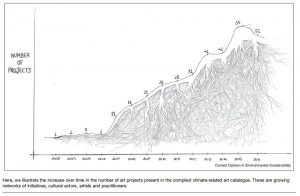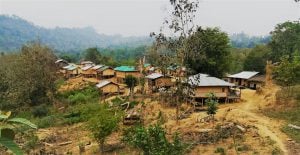This is the third part in a series. Read Part I here, and Part II here.
Sediment remains a serious problem on the Sundari River, causing a gradual but continuous rise of the river bed relative to the surrounding land. Locals say that water buffalo could once pass underneath the bridge where the East-West highway crosses the river, but now they must be herded around it, due to the siltation. A little downstream, the fields farmed by Raghunathpur residents are at least one metre lower than the riverbed on the other side of the embankment. Eventually, if they do not break first, the embankments will over-top.
Some locals suggest that the embankments be built higher; others propose the government use excavators to dig out all the sediment. But experts at the DWIDM doubt these solutions are feasible.
Manohar Kumar Shah, a civil engineer who heads the DWIDM’s regional office in Lahan, about an hour’s drive west from the Sundari, says that raising embankments can make them exponentially more expensive. Likewise, sediment removal is impractical.
“Removing is not possible,” Shah says. “It’s too much sediment. Some you can use in the construction of road, or filling of ditches. But large sediment you cannot. Removing of heavy sediment is very, very difficult. You need more and more money to transport that sediment. And where can you put it down? Dumping of sediment is also a big challenge.”
Shah suggests that the solution is instead to control erosion in rivers’ upper catchments through integrated watershed management, which is the purview of the Ministry of Forests’ Department for Soil Conservation and Watershed Management (DSCWM), established in 1974. The DSCWM central office lies in a sleepy compound in the Maiti Ghar neighborhood of Kathmandu; it is much smaller than the DWIDM and has a budget a fraction the size – roughly NPR 2 billion (USD 18 million) last year. On the second floor, Prem Prasad Paudel, the department’s planning officer, sits at a desk overlooking a jacaranda tree.
Paudel contrasts his office’s approach with that of the DWIDM, saying, “Other departments believe [it] is their mandate just to protect the immediate embankment.” In contrast, he says DSCWM believes that “If you do not manage the sediment load in the upstream area, then only embankment construction does not matter. It’s not sustainable.” DSCWM helps control erosion through activities like building check-dams on small streams and planting trees and grasses along steep slopes to control and remedy landslides.
Paudel concedes that “erosion is a natural process” but says “it can be mitigated. It can be managed. It can be reduced.”
An explosion of infrastructure
Nonetheless, an explosion of infrastructure in the hills has made erosion worse. In recent years, Nepal has averaged over 1,500 kilometres of new road construction annually. A 1,776-kilometre national mid-hill highway is under construction across the country, although some of the most haphazard construction occurs on local roads built by rural municipalities. Meanwhile, a construction boom has spurred rampant mining of river beds in the Siwalik range. Sand is extracted in the Siwalik, rather than further downstream where floods occur, because it is of higher purity. Although limited scientific research has been conducted on the topic, anecdotal evidence and some small-scale studies in Nepal show that such activities significantly increase river sediment loads.
![Haphazard road construction above a river in Sindhuli district in Nepal’s mid-hills [image by: Peter Gill]](https://dialogue.earth/content/uploads/2018/08/IMG_7652.jpg)
In the late 1970s, following the publication of a book by an American journalist on the dangers of rapid population growth and environmental destruction worldwide, concern spread about erosion in the Himalayas. Supporting what became known as the Himalayan Degradation Theory, some researchers argued that widespread conversion of forests to agricultural land in Nepal’s hills and mountains was causing erosion, leading to floods as far downstream as Bangladesh.
Despite its initial popularity, the theory lost traction by the late 1980s, as researchers showed that human land use was negligible compared to high natural rates of erosion. The theory’s critics argued that the Himalayas’ natural steepness – especially in eastern Nepal, the fastest growing part of the range and home to Mount Everest – was the primary factor in erosion. Among other evidence, they pointed to the fact that rivers had always meandered significantly in the plains, and drill hole studies that showed river sediments as far as 5,000 metres below the surface of the Gangetic plain. This was historical evidence of erosion on a massive scale, pre-dating human interventions.
Exploring options
If sedimentation makes embankments infeasible on many rivers, what are the other options?
On the Koshi, the proposal for a high dam at Barahakshetra is from time to time revived, but work has never progressed beyond initial studies. This is often attributed to ongoing distrust between Nepal and India regarding water agreements, but there are also social and technical objections. The reservoir for the 269 metre dam would inundate 200 square kilometres, displace 75,000 Nepalis, and although a detailed assessment has yet to be conducted, it would be expensive.
Proponents argue the dam could help pay for itself by producing up to 3,000 MW of electricity, making it one of Nepal’s largest proposed power stations, but sceptics point out that flood control and power generation are conflicting objectives. While flood preparation requires that reservoir levels be kept low, efficient power generation requires that they be kept high. Following destructive earthquakes in Nepal in 2015 as well as studies suggesting that large reservoirs can induce seismic activity, there are also concerns about safety: damage to the dam could lead to a catastrophic flood. What is more, the sediment predicament remains – rapid siltation of the reservoir could decrease its lifespan and economic viability.
Some experts and activists call for an alternative approach to thinking about floods, focusing on smaller, lower-risk technical and institutional fixes.
Practical Action, an international NGO, recently published a report examining the government’s response to floods in August 2017, when a series of cloudbursts hit Nepal and India. The floods killed over 1,000 people in total, including 134 deaths in Nepal and USD 584.7 million in damages across the country. The Practical Action report notes that flood early warning systems have improved dramatically over the past decade or two. For example, Nepal’s Department of Hydrology and Meteorology sends forecast-based warnings via text message to citizens in specific watersheds, and there are various community-based groups that monitor and disseminate information about upstream water levels on major rivers. Crucially, these warnings did not lead to preparations 2017. Government authorities carried out no evacuations, nor did they pre-position necessary supplies in the days before the floods hit, according to the report.
At Practical Action’s office in Kathmandu, Dinanath Bhandari, the report’s lead author, says that, with the exception of embankment construction, a “response mentality” rather than a “prevention mentality” prevails in the government regarding floods. District and municipal level disaster committees spend nearly all of their budgets on relief rather than preparedness. Had central and local authorities done more to prepare and evacuate, he thinks more lives, property and livelihoods could have been saved.
Ajaya Dixit, a former professor at Nepal’s Institute of Engineering and director of the NGO Institute for Social and Environmental Transition, has for the past three decades advocated alternatives to embankments. Sitting at a posh cafe in Kathmandu’s Baluwatar neighbourhood, he looks very much the part of an engineer, with a short-sleeved collared shirt and eyes framed by black horn-rim glasses.
Dixit has written that embankments create a false sense of security. Once built, the temporary protection they provide can lull the government and private citizens into constructing homes and infrastructure that is woefully ill-prepared for floods. In general, building on flood plains should be avoided, but Dixit acknowledges that some inhabitants are among Nepal’s poorest citizens, “They’re not there because of their own choice. They’re there because historical, social and other factors forced them to live there.”
Dixit argues that houses should be constructed more safely by building on raised plinths, or even on stilts – a style of architecture that is found only sporadically in Nepal. Building codes are rarely enforced in Nepal, and many buildings are built in flood-risk areas. Likewise, roads across the plains block the natural flow of water because they are built on raised platforms but are not outfitted with sufficient culverts or bridges, leading to water-logging and frequent damage. In agriculture, Dixit and others have advocated varieties of rice and other crops that can withstand longer periods of inundation.
![A house built on stilts in Sunsari district [image by: Peter Gill]](https://dialogue.earth/content/uploads/2018/08/IMG_8976.jpg)
A false sense of security
Rajiv Sinha, an Indian professor at the Indian Institute of Technology-Kanpur, has argued that in some places where embankments have breached, the Koshi should be allowed to flow where it wants to. Dixit says he is cautious about decommissioning existing embankments, noting that serious study is needed. “It requires a lot of technological and scientific analysis. I would focus on recognising the limitations, proper maintenance and making sure that we do not give people a false sense of security.”
In general, Dixit advocates for a more humble approach to engineering, a deeper understanding of rivers’ nature, and more flexibility, especially in the face of increasing uncertainty posed by global climate change.
And yet, he believes Nepal is unlikely to change its embankment-centric approach to floods anytime soon. “It’s simple, it’s tangible, you can do it. There is money, and so it fits into the interests of the politicians, also the bureaucrats and a section of the market. So I think you will continue to see that trend,” he says.
Dixit’s outlook calls to mind the words of the philosopher Heraclitus, “No man ever steps in the same river twice, for it is not the same river and he is not the same man.” While geomorphologists would certainly endorse the ancient Greek’s characterization of rivers as ever-changing, one wonders whether he underestimated human stubbornness. Perhaps Karl Marx was closer to the truth when he declared that history repeats itself, “first as tragedy, then as farce.”
Surviving the flood
On the outskirts of Kusaha today, a new hotel is under construction. After the embankment breached ten years ago, it covered the area in several feet of sand. A local real-estate developer bought over ten hectares (0.1 square kilometres), and is making a tourist attraction: The Beach Desert Safari Resort.
So far, a restaurant has been constructed and several dozen full-grown palm trees were transplanted, though most failed to take root and stand desiccated, giving the grounds a forlorn feel. There are plans for a swimming pool and a beach volleyball court, and to introduce all-terrain vehicles for driving on sand dunes in the back.
Satish Chaudhary, the property’s caretaker, predicts a bright future. “How many people go to Goa just to see the sand? Well, now we have that same sand right here!”
![The Beach Desert Safari Resort in Kusaha [image by: Peter Gill]](https://dialogue.earth/content/uploads/2018/08/IMG_9045.jpg)
Samsul Mia, 47, a farmer, says that he lost two bighas – nearly 15,000 square metres – to sand-casting from the flood. Like most villagers, he received compensation from the Indian government: NPR 400,000 (roughly USD 3,640), which he claims was shared among his nearly 40-member family. Though he initially tried farming watermelons and some sand-tolerant vegetables with the support of a UNDP project, he now works as a wage labourer in a neighbouring village.
“Now this land doesn’t produce anything to eat,” Mia says. “It’s useless now.”
Several kilometres away, Sanjay Kumar, an Indian sub-divisional officer for the Koshi Project, stands on the embankment, supervising a contractor working nearby. A team of men is aboard a small barge in the river, dredging a pilot channel to divert the river away from the embankment.
Surveying the situation, Kumar says, “It’s a good sign – the river is flowing to that side. Here [near the embankment’s edge] the water is still, it has no velocity.” He checks an update on his phone: the day’s discharge is just under 2,000 cubic metres per second. He isn’t worried.
According to engineers and locals, the Koshi Project has stepped up maintenance work on the eastern embankment in Nepal since the 2008 breach. India also added a black-topped road to the embankment in 2012, which raised its height by about a foot.
Where will the sediment go?
When the project digs pilot-channels, the debris is sometimes dumped on the outside of the embankments, but there has been no large-scale removal of sediment to date. Dipendra Kumar Rau, a sub-engineer with the project, says that the problem of how to remove the sediment has not been solved yet.
According to one study, the river bed inside the embankment lies two metres higher than the surrounding land on average; in some places, the difference is four or more meters. Removal of all the extra sediment above the barrage – roughly 300 million cubic metres – would require about 107 million Mahindra LoadKing tipper trucks and probably over a dozen square kilometres to dump it on. Even if it were possible, such an operation would do serious harm to riverine ecosystems and violate the rules of the Koshi Tappu Wildlife Reserve, which today constitutes a large portion of the area.
A little further upstream, at the village of Rajabas, the river drifts to the east and aims nearly perpendicular to the embankment before making a sharp turn back to the west. Because of this worrisome bend, the Koshi Project has placed guards on several of the spurs to keep watch at all hours, and it has stockpiled thousands of sandbags for emergency use.
At the end of one of the spurs sits a local resident named Padam Bahadur Sapkota, staring out at the grey water and an overcast sky. Sapkota says he is 76 and has lived in Rajabas for 53 years, long enough to see the river rise and fall and twist and turn many times.
He says he is not worried about the risk, at least this year. “There isn’t risk like before. A few years ago, the river was narrow, and it was coming [towards the embankment] with force. Right now there isn’t the same force.”
Reached later by phone, Prakash Das, the Chief Engineer of the project, concurs. He says, “The Koshi embankment is 100% safe.”
This is the concluding chapter of a three-part series on the Koshi river, and the politics of embankments and floods in India and Nepal, on the tenth anniversary of one of the biggest embankment breaches ever experienced along the river.
![<p>Embankment construction on the Sundari river near Raghunathpur [image by: Peter Gill]</p>](https://dialogue.earth/content/uploads/2018/08/IMG_9106.jpg)


![Peafowls have become a menace in LunchaKameru village in Sumbuk block of South Sikkim, so every morning desperate villagers go to an open patch of land in forest to spread feed for peafowls in the hope that their crops will be spared. They have also constructed water basins out of bamboo [image by: Nidhi Jamwal]](https://dialogue.earth/content/uploads/2018/08/HWC1-300x172.jpg)



![A resident of Raghunathpur standing on an embankment with bamboo revetment on the Sundari river [image by: Peter Gill]](https://dialogue.earth/content/uploads/2018/08/IMG_9311-300x225.jpg)